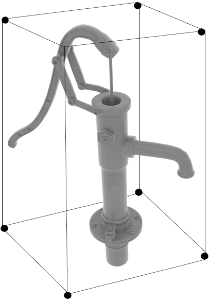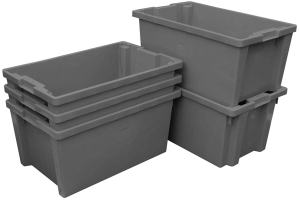There are many things to consider while selecting a location and/or a structure in which to establish a warehouse/storage facility. Rapid assessment templates for identifying storage space can also be found in the Assessments and Planning section of this guide.
Anticipated Cargo Needs
When planning a new warehouse space, organisations should consider what the anticipated cargo needs will be. Cargo needs will at least include the maximum anticipated volume at any given time, however they should also factor for special handling requirements or special activities, such as kitting. Understanding the full scope of the warehouse may require consultations between program and logistics personnel, and a mapping of programmatic activities over the coming period of time. Even a relatively small volume of cargo may require a large area in which to operate.
When anticipating the cargo and relief item storage needs, some of the following items should be considered:
- Total anticipated volume of cargo for the specific storage location.
- Numbers and types of independent types of goods (SKUs) needing to be accounted for.
- Interior space adequate for the anticipated flow of work.
- Need for handling equipment (MHE) for cargo items – MHE parking spaces, recharging, etc.
- Duration stored goods will stay for / the duration the storage site may be required for.
- Need for ancillary activities – repacking, labelling, kitting, break bulk, etc.
- Speed at which throughput/ancillary activities may be required – multiple loading bays, large dispatch area, etc.
- Need for special storage - cold chain, dangerous goods, etc.
- Additional planned buffer stock required.
More information on identifying and estimating cargo can be found in the section Finding Cargo Dimensions.
Irregular and Special Storage
As agencies attempt to plan out space need in storage locations, they may encounter bulky or irregular items. In addition to planning generic outside dimensions, space planners should also estimate the fully required volume to adequately store an item, not just the outside dimensions.
Irregular Shapes - Some irregular items, such as mechanical or farm equipment may have complex physical attributes that make space planning hard. When looking at highly irregular shapes, planners should consider the outside measurement of only the longest, widest and tallest parts of the item, as those are the parts that will come in contact with other stored items in a warehouse. To do this, planers should imagine an invisible box that is barely large enough to fit the irregular item, and use the “edges” of the “box” to calculate the total required space. In this way, the overall space requirement may actually be larger than they first appear.
| |
Nested Cargo – Some cargo items can be neatly “nested,” meaning that they can rest inside of or occupy space inside of each other. Buckets – a common humanitarian item – can fit inside one another, taking up considerably less space when stored appropriately. When planning space, organisations should account for nested storage by measuring the outer dimensions of the items while stacked/nested, and not the outer dimensions of the individual unit. In this way, overall space requirement may actually be less than they first appear.
|
Physical Storage Space Aspects
Once the anticipated project and volume needs are established, organisations planning storage should review and assess the physical aspects and amenities associated with a potential storage space. Though there may be enough interior space to accommodate purely volumetric calculation, warehouses and storage sites may be lacking key infrastructure, or require substantial improvement to meet operational needs. A non-comprehensive list of physical space needs might include:
Physical Terrain:
- Ample space for trucks to enter, park, load/offload and turn around.
- Warehouse/storage site is not prone to flooding or other extreme weather events.
- Impact on the soil/sand/ground in the truck parking/offloading areas and kitting areas during routine activities – will the ground remain unaffected, or will improvement and maintenance be required.
Utilities/Amenities:
- Location/Building has access to basic unities - electricity, water, communications.
- Location has bathroom facilities on site.
- If required, the storage space has separated compartments for different storage areas/different storage needs – climate controlled, secured areas, etc.
- A usable office space of appropriate size.
- The capacity to refuel trucks – does the site have existing refuelling tanks, or do tanks need to be installed.
- An employee break/rest area.
- Prayer rooms (if required).
Structures:
- Proposed warehouse site has an existing physical structure.
- Existing structure and surrounding grounds are in good condition – if not, consider required upgrades.
- If required, location has drive-up loading bays for vehicles.
- Location has adequate walls, doors, and ceilings – if not consider cost and complexity of required repairs.
- If required, location has existing racking/shelving.
- Storage space floors smooth and free from cracks, and capable of supporting required activities.
- Walls are flat and free from pipes, exposed electrical wiring, support beams or other protrusions that might impact storage.
- Structure is free from any perforations that may lead to water or pests coming into the facility.
- There is proper drainage around structure – if not, consider cost and complexity of making drainage.
General Storage Location
The geographic location of the proposed site is also important – a poorly situated site may impact costs and time to adequately delivery humanitarian aid, and generally reduce opportunity to access markets and services. General things to consider when selecting a storage site are its proximity to key things, such as:
- Proposed site location is near the primary areas of intended use.
- If in a capital city, consider the need for the warehouse to be near the airport/seaport.
- If in a field setting, consider the need for the warehouse to near the intended distribution sites.
- Proposed storage site is near major arterial roads used for transport.
- Proposed location as easy access to transporters and casual labour.
- Storage facility will be easily accessed by organisation personnel.
Safety and Security
Overall safety concerns should be included in planned warehouse and storage space. Safety measures might include the physical components of a warehouse, but also the prevailing security surrounding the proposed location. When considering safety needs of a proposed site, organisations should also include security personnel in the planning process.
- Physical structure has a fire suppression system, and emergency exits – if not consider costs of installing fire suppression equipment.
- Storage location has built up walls/fences and access gates.
- Storage location has guard post and guard quarters, and possibly available guard service – many storage sites will require agencies to contract their own guards.
- Warehouse is not near any known or anticipated major targets - military bases, police stations, government offices, etc.
- Warehouse is not near potential hazards – chemical processing depots, fuel stations, landing strips, etc.
- Area is not known for security incidents in the past.
- Proposed location is not exposed and relatively inconspicuous, if possible.



